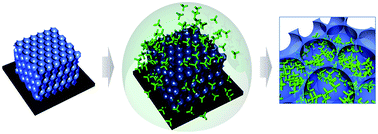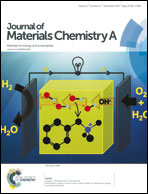Tetrapod CdSe-sensitized macroporous inverse opal electrodes for photo-electrochemical applications†
Abstract
Quantum dots (QDs) possess promising characteristics that are important to light harvesting, but their mesoscale size limits their application in the direct sensitization of TiO2 porous films for photo-electrochemical cells (PECs). Here, inverse opal (IO) TiO2 structures were sensitized by tetrapod-CdSe (tp-CdSe) QDs, which were used in visible-light PECs. Because of the interconnected macropores in the IO structure, tp-CdSe penetrated the entire film and deposited on its surface. In contrast, infiltration was limited to the surface of the conventional mesoporous TiO2 film. The amount of tp-CdSe deposited was dependent on the immersion time of the film in the tp-CdSe dispersion. Optimum deposition of tp-CdSe was observed at the highest photocurrent density. Light harvesting, thus the photocurrent, increased with increasing amounts of deposit, but there was a corresponding decrease in electron lifetime. The maximum photocurrent density per Cd mass was 0.474 mA cm−2, which is greater than previous results from experiments using QD-sensitized PECs. We thus believe that a combination of tetrapod QDs and the TiO2 IO film may provide a new platform for PEC electrodes.


 Please wait while we load your content...
Please wait while we load your content...